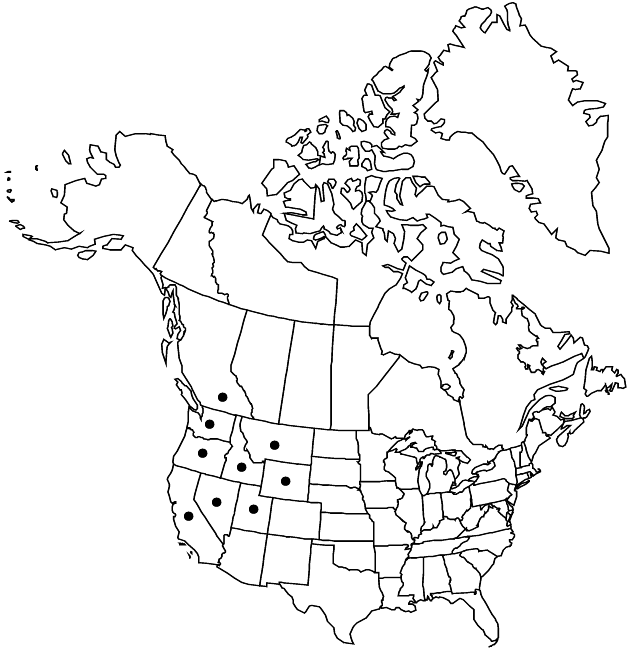Eriophyllum lanatum
Hort. Woburn., 183. 1833.
Perennials or subshrubs, 10–100 cm (sometimes flowering first year). Stems erect to decumbent (usually woolly). Leaves (proximal usually alternate): blades mostly lanceolate to oblanceolate, 1–8 cm, often 1–2(–3)-pinnately lobed, ultimate margins toothed, serrate, or entire, revolute or plane, faces hairy, often woolly (more densely abaxially, sometimes glabrate adaxially; distal leaves reduced in size and lobing). Heads borne singly or (2–5+) in corymbiform arrays. Peduncles mostly 3–30 cm. Involucres campanulate to hemispheric, 6–15 mm diam. Phyllaries 5–13(–15), distinct or connate at bases (lanceolate to ovate, carinate or plane). Ray florets 0 or 5–13(–15); laminae golden yellow to yellow, 6–20 (× 2–7) mm. Disc florets 20–300; corollas 2.5–5 mm (tubes usually glandular or glandular-hairy, glabrous in var. hallii). Cypselae 2–5 mm; pappi usually of 6–12 ovate or cuneate to lanceolate or lance-linear (often unequal), erose or lacerate scales 0.3–2 mm, sometimes coroniform, rarely 0.
Distribution

B.C., Calif., Idaho, Mont., Nev., Oreg., Utah, Wash., Wyo., Mexico (probably extinct).
Discussion
Varieties 10 (10 in the flora).
Eriophyllum lanatum is a polyploid complex of intergrading regional facies treated here as varieties. Artificial hybridization studies show that strong barriers to interbreeding exist among the varieties at the diploid level (J. S. Mooring 2001). In nature, morphologically intermediate polyploid populations often occur in regions where the ranges of the varieties approach one another. Edaphic factors and light intensity also make identification more difficult by strongly influencing leaf morphology and sizes of structures. For example, cultivated individuals of var. achillioides may have laciniately toothed rather than pinnatifid leaves. Rarely, plants of different varieties maintain their identity while growing side by side. In some instances, one is diploid and the other tetraploid; in others both are diploid. Varieties arachnoideum, croceum, grandiflorum, and obovatum apparently form natural hybrids with E. confertiflorum var. confertiflorum; past hybridizations may have resulted in the origin of E. latilobum and E. jepsonii (L. Constance 1937; P. A. Munz 1959; Mooring 1994) and E. confertiflorum var. tanacetiflorum (Mooring 1994).
Our treatment of Eriophyllum lanatum closely follows that of L. Constance (1937), which was done without benefit of cytogeographic studies. The key is to modal populations of the varieties, usually based on living plants.
Some varieties have been introduced into cultivation as ornamentals.
Selected References
Lower Taxa
Key
| 1 | Ray florets 8–9 (disc corolla tubes glabrous; s California) | Eriophyllum lanatum var. hallii |
| 1 | Ray florets usually (5–)8–15, rarely 0 (disc corolla tubes glandular or glandular-hairy) | > 2 |
| 2 | Pappi to 0.2 mm, sometimes coroniform, rarely 0 | > 3 |
| 2 | Pappi (0.3–)0.5–2 mm | > 4 |
| 3 | Proximal leaves pinnately lobed, lobes 3–5, abaxial faces loosely cobwebby-woolly; California, Coast Ranges | Eriophyllum lanatum var. arachnoideum |
| 3 | Proximal leaves coarsely serrate or shallowly lobed distally, abaxial faces densely silky-woolly; California, Sierra Nevada | Eriophyllum lanatum var. croceum |
| 4 | Proximal leaves 1–2(–3)-pinnately lobed | > 5 |
| 4 | Proximal leaves laciniately toothed, serrate, or entire | > 8 |
| 5 | Proximal leaves 1-pinnately lobed; peduncles mostly 5–30 cm | > 6 |
| 5 | Proximal leaves 1–2(–3)-pinnately lobed (sinuses almost to midribs); peduncles mostly 3–15 cm | > 7 |
| 6 | Proximal leaves usually lobed (beginning in proximal 1/2 of leaf); peduncles mostly 10–30 cm; California, sw Oregon | Eriophyllum lanatum var. grandiflorum |
| 6 | Proximal leaves usually lobed (beginning in distal 1/2 of leaf); peduncles mostly 5–15(–20) cm; Idaho, Montana, ne Oregon, e Washington | Eriophyllum lanatum var. lanatum |
| 7 | Perennials (often clumped); proximal leaves usually mostly opposite, 1(–2)-pinnately lobed, lobes ± linear (with 0–2 teeth, ultimate margins not crispate), abaxial faces usually densely gray-woolly; heads 2–5 per array or borne singly; ray laminae 8–20 mm; British Columbia, sw Oregon, Washington | Eriophyllum lanatum var. leucophyllum |
| 7 | Perennials (sometimes flowering first year); proximal leaves usually mostly alternate, 1–2(–3)-pinnately lobed, lobes usually ± triangular (with 0–4 teeth, ultimate margins often crispate), abaxial faces woolly; heads usually 3–8 per array; ray laminae usually 6–9(–16) mm; California, Nevada, s Oregon | Eriophyllum lanatum var. achilleoides |
| 8 | Leaves: margins revolute, abaxial faces woolly, adaxial tufted-woolly or glabrate | > 9 |
| 8 | Leaves: margins usually plane, sometimes slightly revolute in var. integrifolium, abaxial and adaxial faces woolly | > 10 |
| 9 | Peduncles mostly 10–30 cm; cypselae (2.4–)2.5–3.5(–4) mm; California, sw Oregon | Eriophyllum lanatum var. grandiflorum |
| 9 | Peduncles mostly 5–15(–20) cm; cypselae (3.4–)3.5–5 mm; Idaho, Montana, ne Oregon, e Washington | Eriophyllum lanatum var. lanatum |
| 10 | Involucres 6–10 mm diam.; ray florets (5–)8(–10) | Eriophyllum lanatum var. integrifolium |
| 10 | Involucres 10–15 mm diam.; ray florets 10–13(–15) | > 11 |
| 11 | Involucres 10–12 mm diam.; ray laminae 6–7 mm; s California | Eriophyllum lanatum var. obovatum |
| 11 | Involucres 12–15 mm diam.; ray laminae 7–10(–15) mm; n California,s Oregon | Eriophyllum lanatum var. lanceolatum |